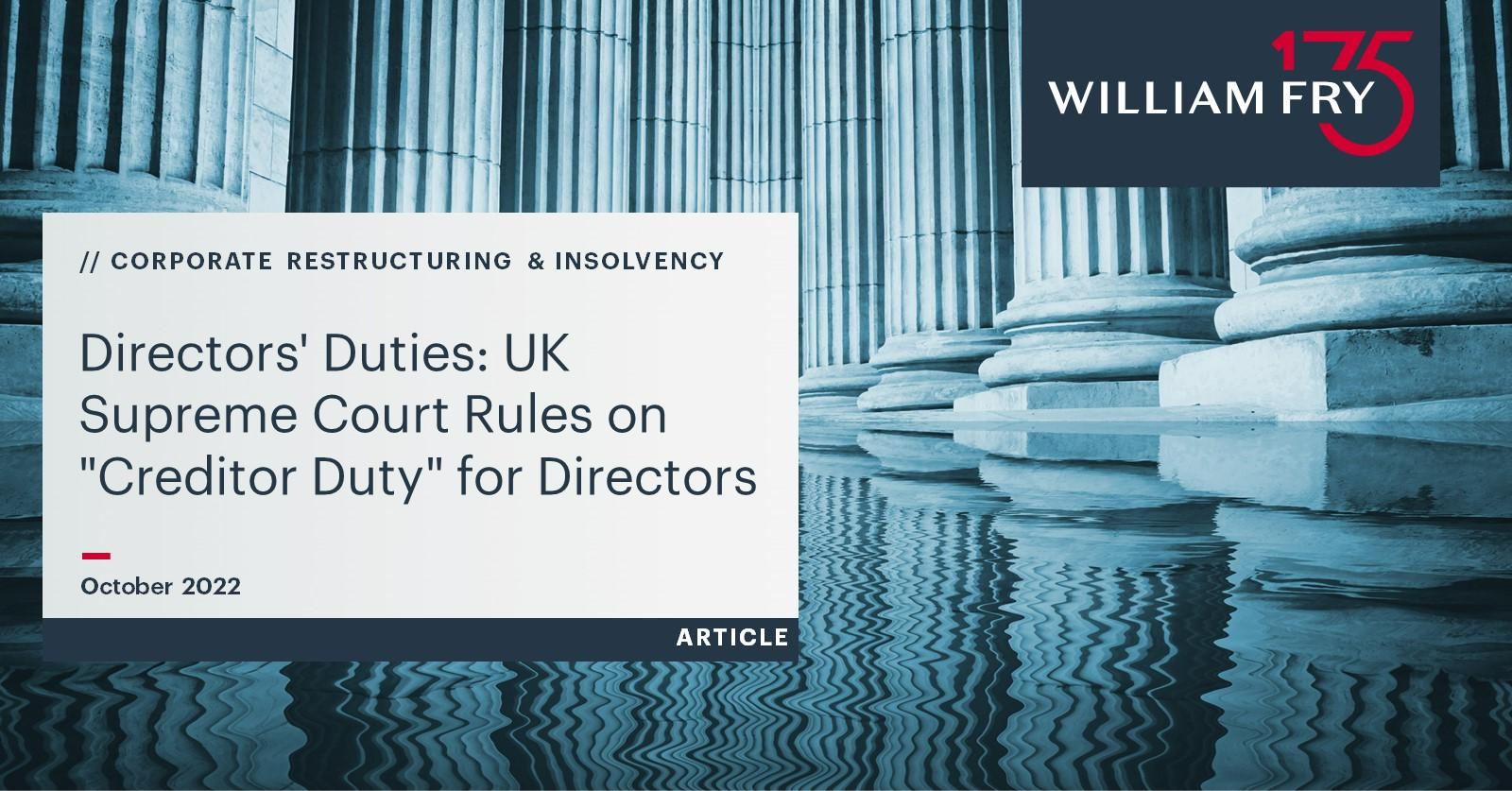Directors’ Duties: UK Supreme Court Rules on “Creditor Duty” for Directors
Under Irish and UK law, company directors owe fiduciary duties to act in good faith in the interests of the company. The company’s interests in this context usually means the collective best interests of the members. However, UK and Irish authorities have developed directors’ common law duties, such that in cases of insolvency, directors have a duty to consider the interests of the company’s creditors.
In July 2022, amendments were made to the Irish Companies Act 2014 (CA 2014) under the Preventive Restructuring Regulations 2022, obliging directors to have regard to the interests of creditors where the company is, or is likely to be, unable to pay its debts. In other words, under Irish law, the common law duty became a statutory duty.
In the UK, this duty of company directors towards creditors was left unresolved under the Companies Act 2006 (UK Companies Act). Whilst the UK Companies Act obliges directors to act in good faith in the interests of the company as a whole, the duty is modified as the UK Companies Act also requires directors to consider or act in creditors’ interests in certain circumstances. This was described by Lord Briggs as the “creditor duty” in a recent UK Supreme Court (UKSC) appeal: BTI 2014 LLC v Sequana SA and others.
The UKSC appeal raised the question whether
- there is any rule of English law giving rise to a creditor duty, and
- if so, its content, and
- the time it arises in the company’s decline towards insolvency and possible liquidation. Is the creditor duty engaged when there is a “real risk”, or a “probability” of, or proximity to insolvency?
Facts
In May 2009, the directors of AWA caused it to distribute a dividend of €135m to its only shareholder, Sequana SA. When the dividend was paid, AWA was solvent on both a balance sheet and a cash flow basis. However, it had long-term pollution-related contingent liabilities of an uncertain amount. There was a real risk, but not a probability, that AWA might become insolvent in the future.
That risk materialised, and AWA went into insolvent liquidation almost ten years after payment of the dividend, in October 2018. AWA assigned its claim to the appellant. The appellant sought to recover the dividend from AWA’s directors. It argued that the directors’ decision to distribute the dividend was taken in breach of the creditor duty because they had not considered or acted in the interests of AWA’s creditors. The appellant lost before the UK High Court and Court of Appeal, which found that the creditor duty did not arise when the company was solvent, and the risk of insolvency in the future fell short of being imminent or probable.
The appellant appealed to the UKSC.
Findings
The UKSC unanimously dismissed the appeal. Lord Briggs delivered the leading judgment, with three other judgments delivered. While the reasoning and emphasis in each of the judgments differ, the following are the majority conclusions:
- A creditor duty is firmly established in English common law.
- The UK Companies Act confirms the existence of this creditor duty.
- There is good justification for the creditor duty, founded on the economic reality that as the company moves towards insolvent liquidation, the creditors’ interest assume increasing importance until they predominate in the liquidation. This is a point when insolvency becomes irreversible.
- It is too early to treat the creditor duty as engaged merely because the company faces a “real risk” of insolvency. The UKSC noted that this is a common feature among companies and is insufficient to require directors to consider creditors’ interests. The directors’ duty at that point remains to promote the company’s success in the interests of its shareholders.
- The creditor duty arises when the directors know or ought to know that the company is insolvent or is bordering on insolvency or that an insolvent administration or liquidation is probable. It is not enough that insolvency itself, from which the company may recover, is probable. Insolvency in this context means cash flow insolvency or balance-sheet insolvency.
- The content of the creditor duty is to give consideration and weight to the creditors as appropriate given the company’s financial circumstances at the time. This requires balancing creditor interests against other interests of the company, including shareholders. In summary,
- where the company is insolvent, or bordering on insolvency, but not faced with an inevitable insolvent liquidation or administration, the directors should consider the interests of creditors, balancing them against the interests of shareholders where they may conflict.
- where an insolvent liquidation or administration is inevitable, the creditors’ interests become paramount.
The UKSC found that the creditor duty had not been engaged on the facts of the case. At the time of the dividend, AWA was not actually or imminently insolvent, nor was insolvency probable. The directors were not under a duty to consider the interests of AWA’s creditors.
Conclusion
The judgment confirms that a creditor duty exists in English law and is instructive in its general guidance as to when that duty is engaged. From an Irish perspective, where the duty to consider creditors’ interests is now expressly provided for under the CA 2014, the importance of the UKSC judgment is its finding that the trigger for engagement of the creditor duty is when there is a “probability” as opposed to a “real risk” of insolvency.
The UK Supreme Court reiterated that the creditor duty is owed to the company and not to the individual creditors. This is in line with Irish law, as confirmed under the new section 224A and 228 of the CA 2014, meaning that it is not directly enforceable by the creditors themselves against directors.
To discuss any aspect of this article in more detail and its impact on your business, please contact a member of our Corporate Restructuring & Insolvency team.
Contributed by Toby Boyd & Gail Nohilly



